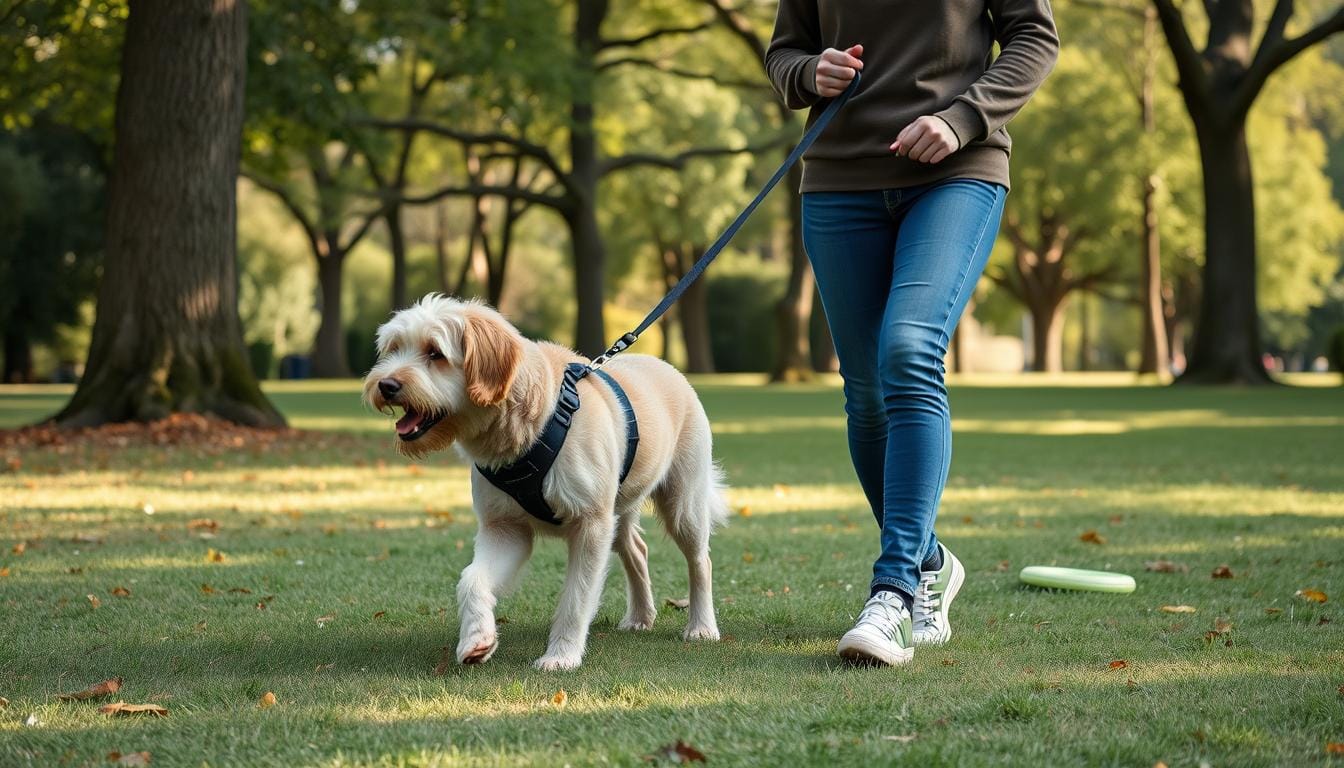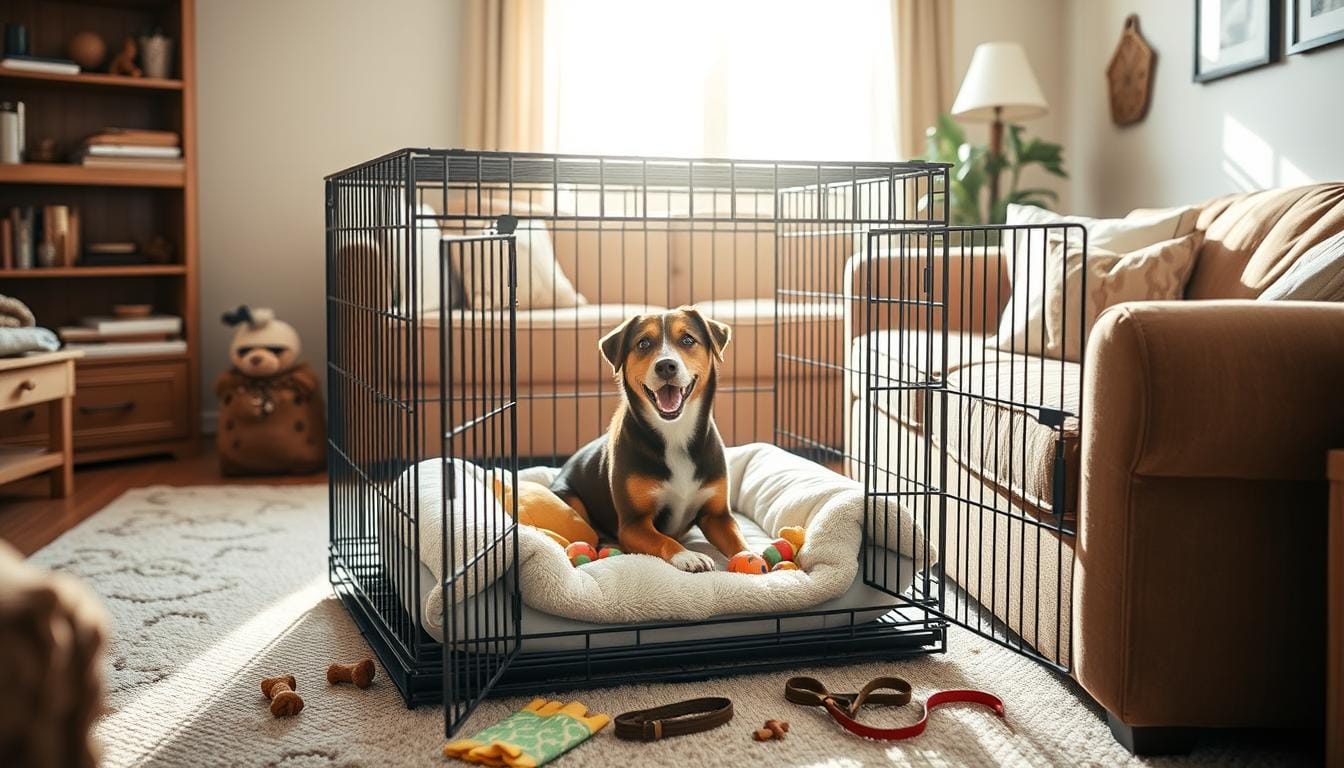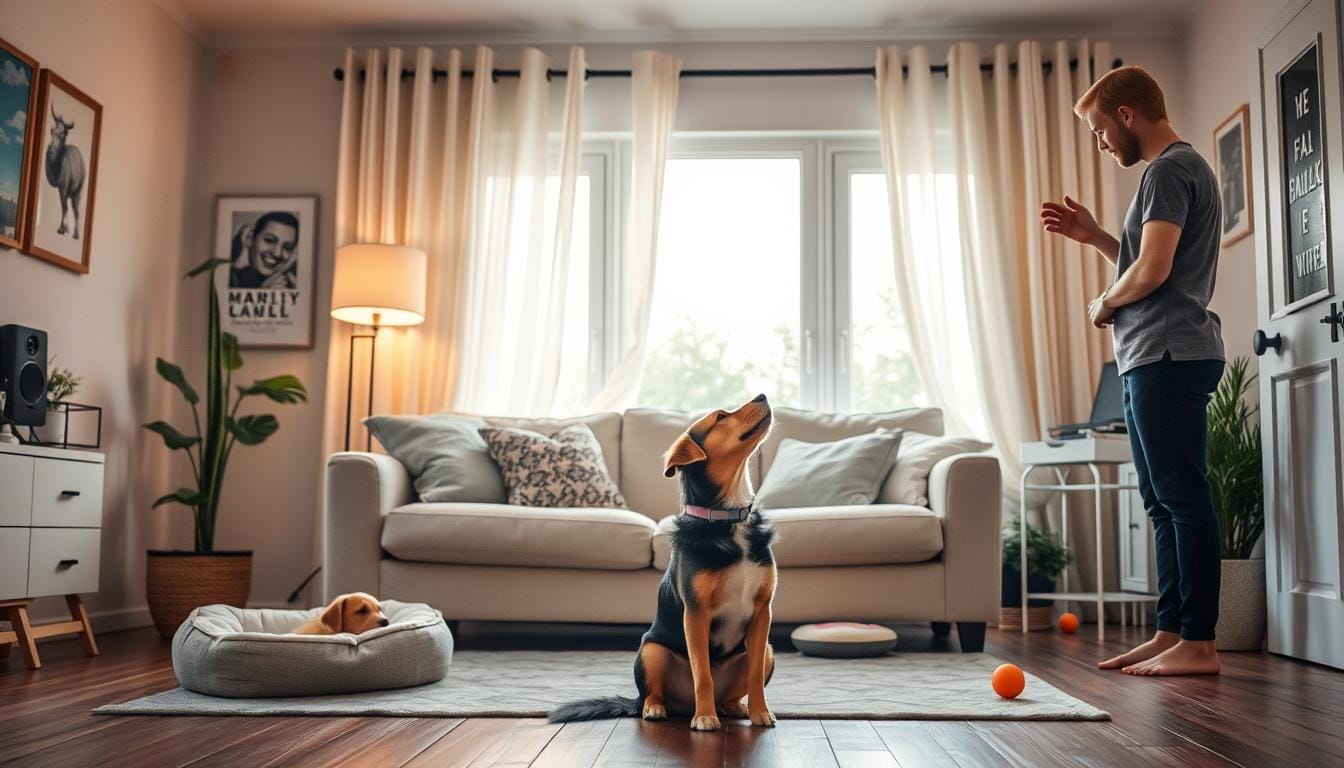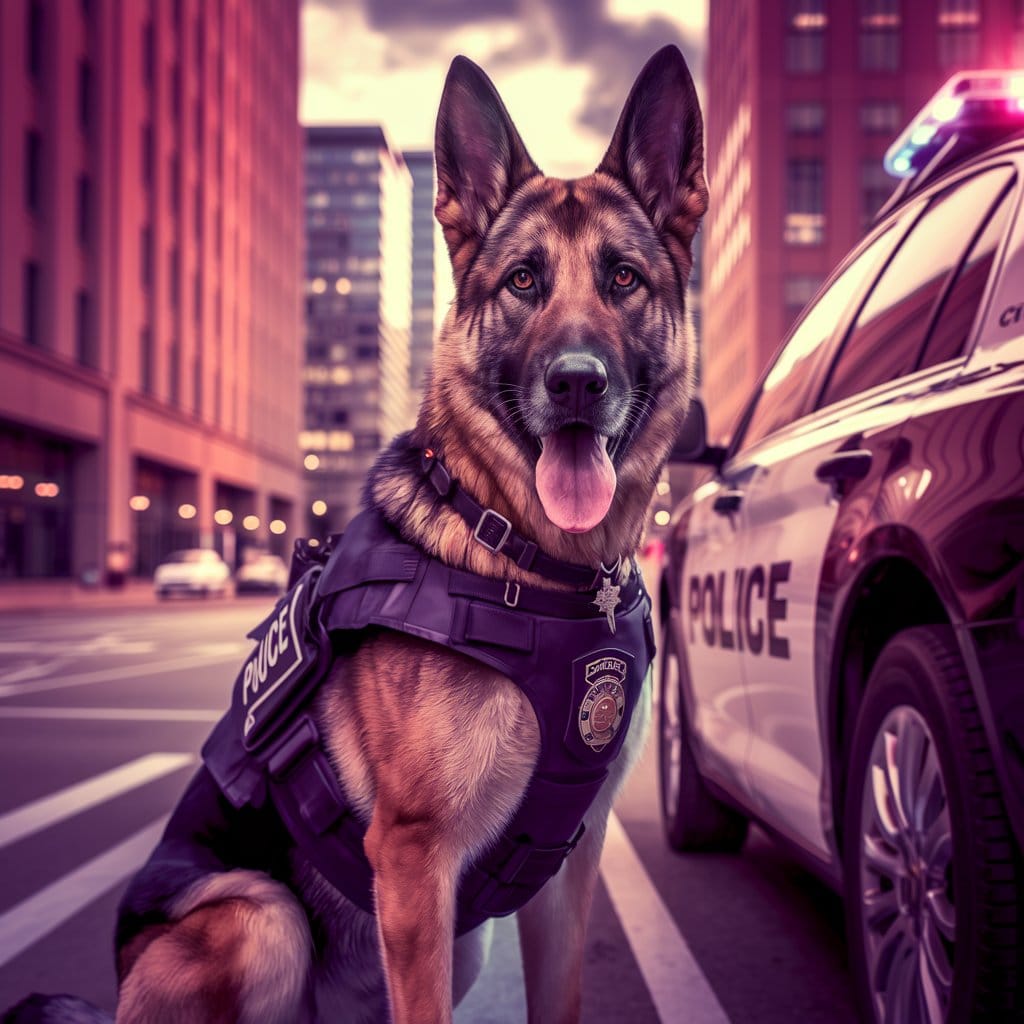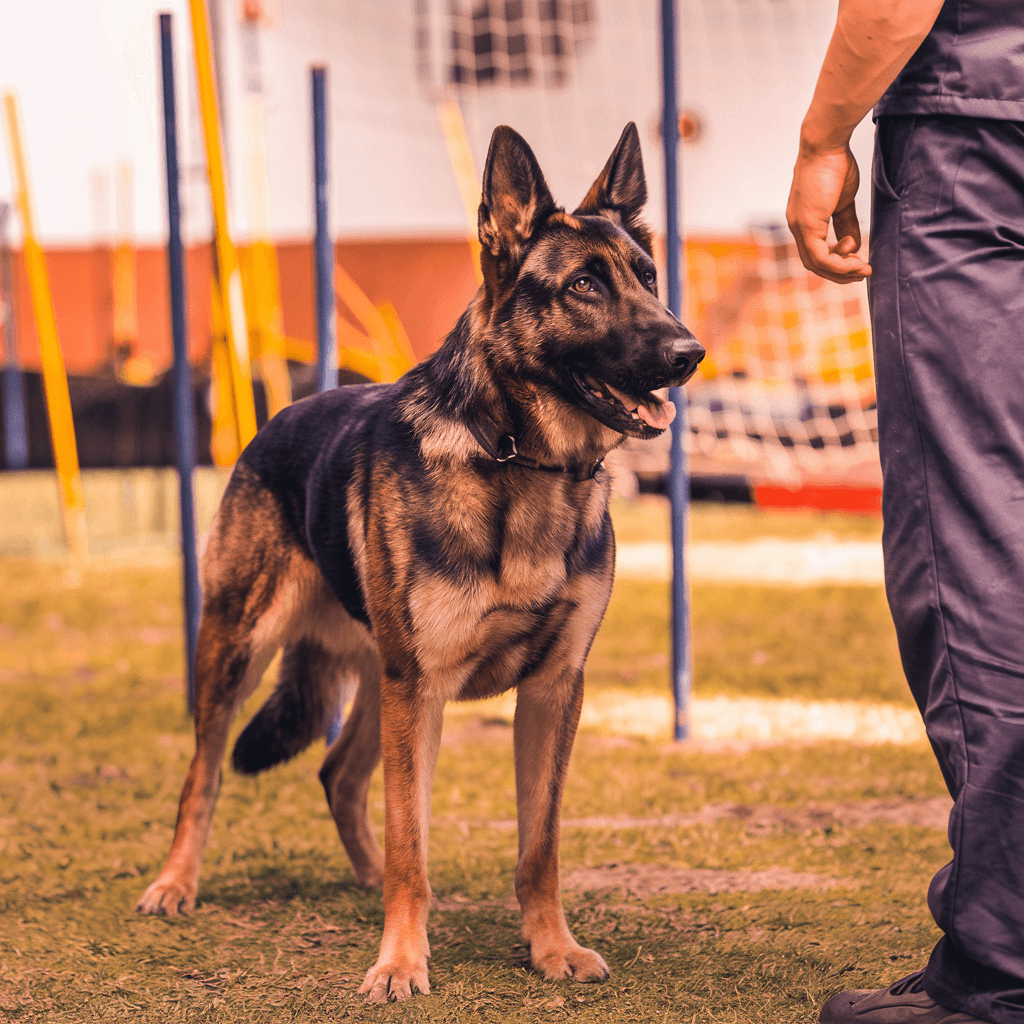Dogs can sense human emotions instinctively. They can read our facial expressions and body language. They even notice changes in our scent.
This emotional intelligence lets them communicate with us. It forms the deep bond we share with our furry friends.
We invite you to explore dog training. It can make this bond even stronger. Whether you’re dealing with dog behavior issues or want to improve obedience, finding the right training is key.
In San Francisco and beyond, many training options are available. You can choose from online courses for flexibility to in-person sessions for tackling tough behaviors. Let’s explore the world of dog training together and find the perfect fit for you and your pet.
Key Takeaways
- Dogs have an innate ability to sense and respond to human emotions
- Dog training enhances the bond between pets and their owners
- Various training options are available, including online and in-person sessions
- San Francisco offers diverse dog training programs to suit different needs
- Proper training addresses behavioral issues and improves obedience
- Choosing the right training method is crucial for success
Understanding the Importance of Dog Training
Dog training is key to shaping our furry friends’ behavior. It helps create a better relationship between pets and their owners. Professional dog training offers many benefits, not just basic commands.
Benefits of Professional Dog Training
Professional dog training tackles common behavioral issues. It also improves communication between dogs and their owners. It boosts dogs’ confidence and makes them love learning.
January is National Train Your Dog Month. It shows how important proper training is.
- Improved communication
- Enhanced confidence
- Better behavior management
- Increased safety for dogs and humans
Common Behavioral Issues Addressed by Training
Dog obedience training solves many behavioral problems. These issues can make the human-canine relationship tough. Some common problems include:
| Behavioral Issue | Training Approach |
|---|---|
| Jumping on guests | Impulse control exercises |
| Separation anxiety | Desensitization techniques |
| Leash pulling | Positive reinforcement methods |
| Aggression | Behavior modification strategies |
Building a Stronger Bond with Your Pet
Dog training makes the bond between dogs and owners stronger. It builds mutual understanding and respect. This creates a positive learning environment.
By understanding dog psychology and their needs, we can build trust. This leads to balanced behaviors in our pets.
“The goal of dog training is to instill awareness in owners so that they can lead their dogs to a healthy and balanced life.”
Effective dog behavior training needs compassion and listening skills. It also requires support from trainers. This helps confused owners and strengthens the bond between dogs and humans. It makes for a more fulfilling relationship.
Types of Dog Training Programs Available
Dog training programs vary to meet different needs and skill levels. We’ll look at the main types to help you pick the best for your dog.
Obedience Training
Obedience training is crucial for good dog behavior. It teaches basic commands like sit, stay, and come. Group classes are common, offering socialization and learning.

Puppy Training
Puppy training focuses on early socialization and manners. It covers potty training and how to interact with others. Starting early is key for a dog’s future success.
Specialized Behavior Modification
Specialized programs tackle specific behavioral issues. They address problems like barking, aggression, or separation anxiety. Trainers work one-on-one to change unwanted behaviors.
Advanced Training for Specific Skills
Advanced programs teach specialized skills. This includes service dog training for dogs to assist people with disabilities. Other skills might be agility, scent work, or therapy dog certification.
| Training Type | Duration | Skills Covered |
|---|---|---|
| Obedience Training | 4-8 weeks | Basic commands, leash walking |
| Puppy Training | 6-8 weeks | Socialization, potty training, basic manners |
| Behavior Modification | Varies | Addressing specific issues like aggression or anxiety |
| Service Dog Training | 18-24 months | Task-specific skills, public access training |
Choosing the right dog training program depends on your pet’s age, behavior, and goals. Whether it’s obedience, puppy classes, or specialized programs, consistent practice and positive reinforcement are essential for success.
Online vs. In-Person Dog Training: Pros and Cons
Dog training has changed a lot, giving pet owners many choices. We’ll look at the good and bad of online and in-person training to help you decide.
Online dog training became popular during the pandemic. It lets trainers reach more people and is convenient. Many like it because you can learn at your own pace from home.
In-person training means you meet trainers and other dogs face-to-face. It’s great for socializing and getting feedback right away. K-9 University in Plano and Garland has been helping North Texas families for over 30 years.
| Aspect | Online Dog Training | In-Person Dog Training |
|---|---|---|
| Accessibility | Train from home, flexible timing | Fixed schedule, travel required |
| Interaction | Limited face-to-face access | Direct interaction with trainer and other dogs |
| Cost | Often more affordable | Can be more expensive |
| Socialization | Limited opportunities | Interaction with other dogs and owners |
| Feedback | May lack real-time feedback | Immediate feedback and corrections |
Online training lets you go back to lessons anytime and learn at your dog’s pace. But, it needs self-motivation and lacks social chances. In-person training offers a set place but might be hard to get to because of fixed times.
Choosing between online and in-person dog training depends on your needs, your dog’s personality, and your life. Both can work well if done right and regularly.
How to Choose the Right Dog Trainer for Your Needs
Finding the right dog trainer can greatly improve your pet’s behavior. We’ll help you find professional dog training that meets your needs. Let’s look at the important factors to consider when picking a trainer for your furry friend.
Qualifications to Look For
When searching for dog trainers near you, check their credentials. Look for certifications from respected organizations like CCPDT or IAABC. These show the trainer has met certain standards and follows ethical practices.
Reading Reviews and Testimonials
Customer feedback is key when choosing a dog trainer. Read online reviews and ask for references from past clients. This helps you understand the trainer’s methods and success rates. Positive reinforcement techniques are often the most effective and humane.
Interviewing Potential Trainers
Don’t be shy to interview potential trainers before deciding. Ask about their experience, training philosophy, and specific techniques. A good trainer will be happy to answer your questions and may even let you observe a session.
| Qualification | Description | Importance |
|---|---|---|
| Certification | CCPDT, IAABC, KPA | Ensures professional standards |
| Experience | Years in the field | Indicates practical knowledge |
| Training Methods | Positive reinforcement | Promotes effective, humane training |
The right trainer will not only help with behavioral issues but also strengthen your bond with your dog. Take your time to find a professional who matches your goals and values in dog training.
“A good trainer doesn’t just train dogs; they educate owners and build lasting relationships.”
Dog Training Near Me: Finding Local Options
Finding quality dog training near me is now easier than ever. We’ve put together a guide to help you find local dog trainers and resources. Let’s look at how to find the best training for your furry friend.
Using Online Directories and Search Tools
Online directories are a good place to start. Many professional organizations have searchable databases of certified trainers. You can filter by location, training specialties, and read reviews from other pet owners.
Asking for Recommendations
Your vet and local pet stores are great sources of info. They often know reputable dog trainers in your area. Just ask for their recommendations during your next visit.
Exploring Community Resources
Community resources offer unique training opportunities. Check with your local parks department or community center for group classes. Some pet-friendly places might even host training events.
| Training Type | Price Range | Duration |
|---|---|---|
| Puppy Kindergarten | $49.99 – $279 | 4 weeks (45 min/class) |
| Basic Training | $150 – $349.99 | 6 weeks (45 min/class) |
| Intermediate Training | $200 – $799 | 4-6 weeks (45 min/class) |
| Specialized Training | $800 – $6250 | Varies |
Prices and options vary a lot. In Baltimore, you can find training for as low as $49.99. But, specialized programs can cost up to $6250. Always think about your dog’s needs and your budget when picking a trainer.
The Cost of Dog Training: What to Expect
Dog training costs can vary a lot. We’ve gathered data to help you understand what to expect when planning for professional dog training.

The average cost for dog training is between $45 and $120 per hour. Group classes are usually cheaper, costing $30 to $60 per hour. Private sessions can range from $30 to $100.
If you’re looking for more intense training, expect to pay $200 to $500 daily. This includes boarding. Package deals are also available, with prices from $500 for a 6-week course to $2,000 for more comprehensive programs.
“Investing in professional dog training early can save you time and frustration in the long run,” says a FitBark pet behavior specialist.
Here’s a breakdown of average costs for different dog training programs:
| Training Type | Average Cost |
|---|---|
| Group Classes (6-8 weeks) | $120 – $600 |
| Private Sessions | $45 – $120 per session |
| Board and Train (1 week) | $500 – $1,250 |
| Petco (6-week program) | $179 |
| PetSmart (6-week program) | $139 |
Keep in mind, costs can change based on the trainer’s experience, location, and your dog’s needs. Think about your budget and what you want to achieve in training before choosing a program for your dog.
Preparing for Your First Dog Training Session
Getting ready for your first dog training session is an exciting step. It’s a chance to improve your dog’s behavior and strengthen your bond. We’ll guide you through the essentials to ensure you’re well-prepared for a successful start.
Essential Items to Bring
Pack these items for your dog training session:
- Treats (small, soft, and high-value)
- Your dog’s favorite toys
- A comfortable leash and collar
- Water and a portable bowl
- Poop bags
Setting Realistic Goals
It’s important to set achievable goals for your dog obedience training. Remember, progress takes time and patience. Focus on one or two behaviors you’d like to address initially, such as:
- Basic commands (sit, stay, come)
- Leash walking without pulling
- Reducing excessive barking
Creating a Positive Learning Environment
A positive atmosphere is crucial for effective dog training. Use reward-based techniques to make learning enjoyable for your pet. Keep sessions short, about 10-15 minutes, to maintain your dog’s interest and prevent fatigue.
| Training Approach | Benefits |
|---|---|
| Positive Reinforcement | Builds confidence, strengthens bond |
| Consistency | Promotes faster learning, reduces confusion |
| Patience | Encourages progress, reduces stress |
By following these guidelines, you’ll be well-prepared for your first dog training session. Remember, every dog learns at their own pace. Stay patient and celebrate small victories in your pet’s behavior improvement journey.
Continuing Education: Maintaining Your Dog’s Training
Dog training is a lifelong journey that needs commitment and learning. We’ve gathered insights to help keep your dog’s skills sharp and behavior in check.
At-Home Practice Techniques
Practice at home is crucial to reinforce your dog’s training. Spend a few minutes each day on basic commands and behaviors. Use treats and praise to keep your dog motivated and engaged.
Advanced Classes and Workshops
For advanced skills, consider advanced dog training courses. These classes focus on agility, scent work, or therapy dog training. There are many continuing education events in the United States and Canada.
| Event Type | Duration | CEU Range | Topics Covered |
|---|---|---|---|
| Workshops | 1-12 days | 1-31 units | Shelter behavior, stress management, aggression |
| Online Courses | Flexible | Varies | Enrichment, specific training techniques |
| Collaborative Events | 2-5 days | 10-20 units | Animal behavior, health, business practices |
Addressing New Behavioral Challenges
As your dog grows, new experiences may lead to unexpected behaviors. Stay alert and address any issues quickly. If needed, seek help from a professional trainer or behaviorist.
Continuing to learn about dog behavior and training will keep your dog happy and well-behaved for years.
Conclusion
Dog training near me in Springville, UT has many options for different needs. You can find classes for obedience, anxiety, and aggression. There are also programs for puppies, service dogs, and personal protection dogs.
Dog obedience training can really change how owners and pets connect. In places like Springville, Alpine, Provo, and Orem, trainers use a balanced method. This method helps dogs learn to respond to commands better.
Many customers are happy with these training programs. The trainers have over 100 years of experience. Whether you need basic training or something more, Springville, UT has what you need. It helps you and your dog become closer.







